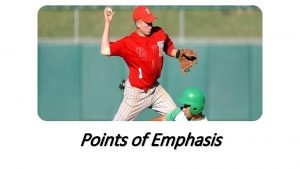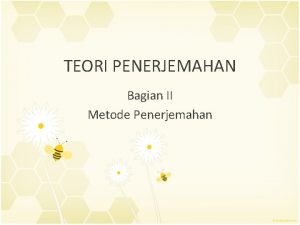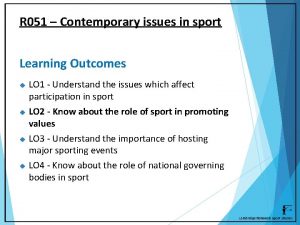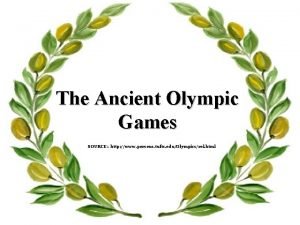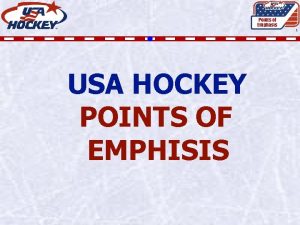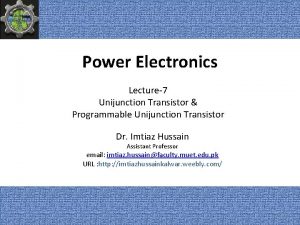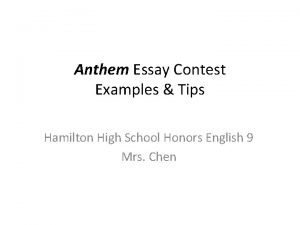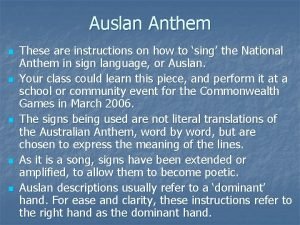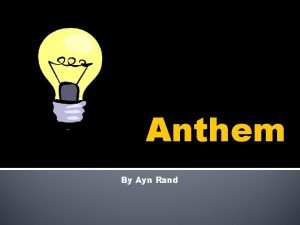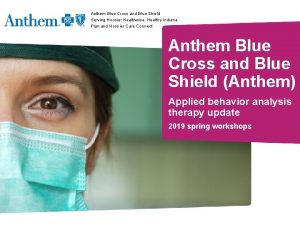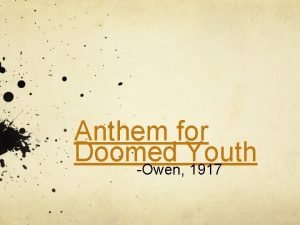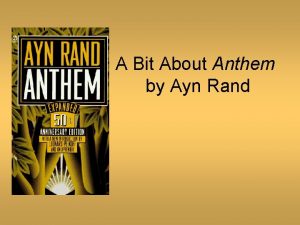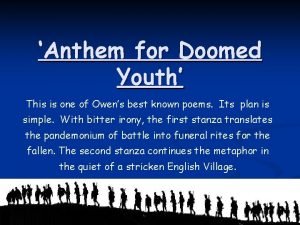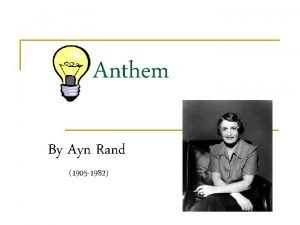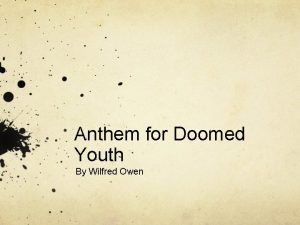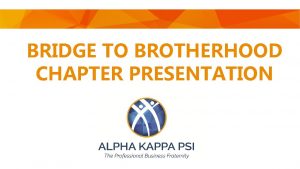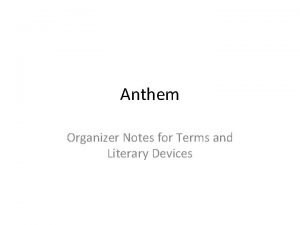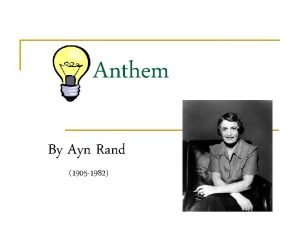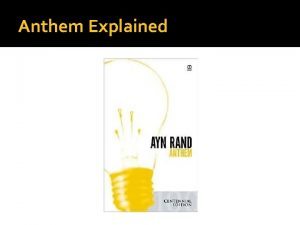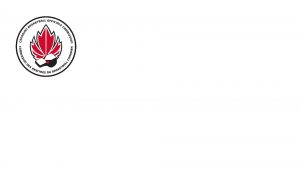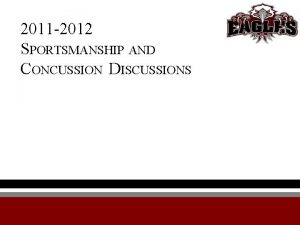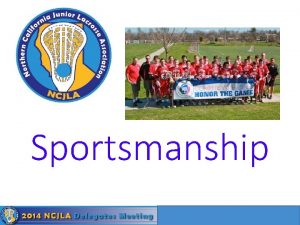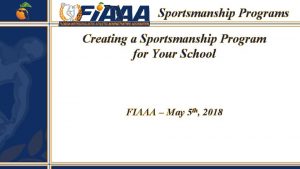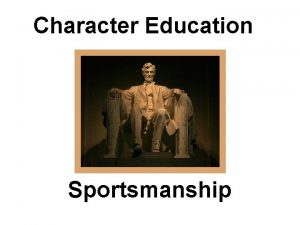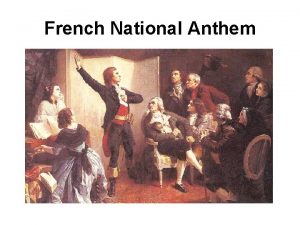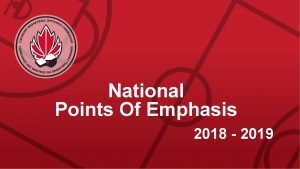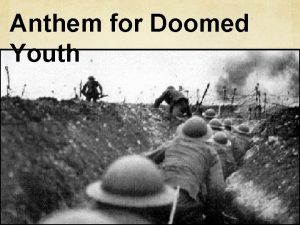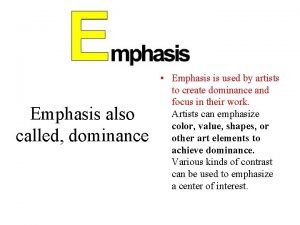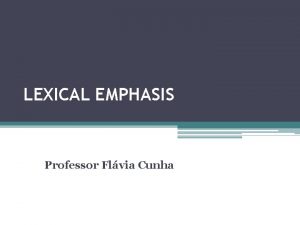Points of Emphasis Sportsmanship National Anthem Standoff National









































- Slides: 41

Points of Emphasis

Sportsmanship: National Anthem Standoff National anthem standoffs do not reflect education-based athletics. Staring down opponents after the national anthem to try to intimidate them or refusing to leave the respective baseline before the other team departs is juvenile and disrespectful. www. nfhs. org

National Anthem Standoff - ENFORCEMENT • Order the Home team’s Head Coach to direct his team to return to his dugout. • If the visiting team doesn’t also immediately leave their side when the home team leaves, order the Visiting team’s Head Coach to direct his team return to his dugout. • Eject anyone who refuses to follow your orders.

Sportsmanship: Bench Jockeying and Celebrations Coaches, players, substitutes, attendants or other bench personnel shall not leave the dugout during a live ball for any unauthorized purposes. PENALTY: Team warning. www. nfhs. org

Sportsmanship: Bench Jockeying And Celebrations Taunting: Players are not allowed to stand outside their dugout/bench area and make “cat -calls” or other disparaging remarks while the other team is taking infield practice. www. nfhs. org

Sportsmanship: Intentional Distractions Taunting: Chants, intentional distractions and loud noises directed at the opponent’s pitcher prior to his pitching, the batter getting ready to hit, or a fielder getting ready to make a play do not represent good sportsmanship. www. nfhs. org

Player’s equipment: Body/Chest protector Per a rule change approved in 2017, the catcher’s body/chest protector shall meet the NOCSAE standard effective January 1, 2020. We assume the protector is legal when the head coach verifies his players are properly and legally equipped. www. nfhs. org

Player’s equipment: Helmets with an attached Jaw Guard Helmets must meet the provisions of Rule 1 -5 -2, including that all face mask/guards attached after manufacture approved by the manufacturer and meet the NOCSAE standard at the time of manufacture. A face mask/guard specifically designed for a particular helmet model may be attached after manufacture, provided that procedure is approved by the manufacturer and meets the NOCSAE standard at the time of manufacture. NOCSAE does not certify Attached Jaw Guards! www. nfhs. org

Player’s equipment: Helmets with an attached Jaw Guard ü Helmets are certified by NOCSAE. ü Attached Jaw Guards are NEVER certified by NOCSAE. ü NJSIAA’s position is that umpires should allow batters to use helmets with attached Jaw Guards as long as the Head Coach verifies at the pregame conference that all his players are properly and legally equipped. www. nfhs. org

Player’s equipment: Bats with detachable knobs Bats shall be unaltered from the manufacturer’s original design and production and must meet the provisions of Rule 1 -3 -2. Illegal www. nfhs. org

Player’s equipment: Bats with “smart” attachments Rule 1 -3 -2. a(2): Bats shall not have exposed rivets, pins, rough or sharp edges or any form of exterior fastener or attachments that would present a potential hazard. • Zepp Swing Analyzer

Baserunner’s responsibilities Legal Rule 2 -32 -1: Runners are never required to slide, but if a runner elects to slide, it must be legal. A legal slide can either be feet first or head first. If a runner slides feet first, at least one leg and buttock shall be on the ground. www. nfhs. org

Baserunner’s responsibilities Illegal Runners may not pop-up into the fielder. www. nfhs. org

Baserunner’s responsibilities Illegal Runners may not have a leg raised higher than the fielder’s knee. Ouch! www. nfhs. org

Baserunner’s responsibilities Illegal Runners may not slide through or beyond the base, except at home plate, www. nfhs. org

Baserunner’s responsibilities Illegal Runners may not slide away from a base in the direction of the fielder. A runner may slide in a direction away from the fielder to avoid making contact or altering the play of the fielder. www. nfhs. org

Baserunner’s responsibilities Illegal The runner is out when he illegally slides and affects the play. On a force play, the runner is also guilty of interference. The batterrunner is also declared out and all runners must return to the base occupied at the time of the pitch. Rule 2 -32 -2 www. nfhs. org

Baserunner’s responsibilities Legal Rule 8 -4 -2. b(2) …Jumping, hurdling and leaping are all legal attempts to avoid a fielder as long as the fielder is lying on the ground. www. nfhs. org

Baserunner’s responsibilities Illegal When illegally executed, as shown in the image, hurdling, jumping or leaping over a fielder supersedes obstruction. Penalty: Interference www. nfhs. org

Baserunner’s responsibilities Illegal Rule 8 -4 -2. d: Diving over a fielder is always illegal. Diving supersedes obstruction. Penalty: The runner is out and the ball remains alive unless interference occurs and is declared. www. nfhs. org

Umpire mechanics

NEW Umpire signal: Information available To assist in providing pertinent information between partners, a new umpire signal — “information available” — was approved. The umpire indicates he or she has relevant information for their partner by tapping two times over the left chest (heart). www. nfhs. org

There are calls in NFHS Baseball which umpires cannot change. • Calls on close force plays. • Tags on non-force situations where the ball is not dropped. • Half-swing when a strike is first called. • Catch/no catch of a fair fly ball with runners on base. • Ejection ##

NEW Umpire signal: Correct rotation The new “correct rotation” signal involves umpires pointing with both hands in the direction of the base that they are moving toward. In three and four-umpire mechanics, umpires can signal to partners which direction they will be rotating to a specific base for coverage of an anticipated play. www. nfhs. org

Many revisions were made in the 2019 and 2020 NFHS Umpires Manual Please read and review. Changes are highlighted in gray.

The 4 times the Plate Umpire will take responsibility for plays at third base? 1) R 1 advancing to third on a base hit to the outfield. PU: “I’ve got third if he comes. ” 2) With R 1 and R 2, a batted FLY ball to the outfield that is caught and R 2 is advancing to 3 B. PU: “I’ve got third if he tags. ”

The 4 times the Plate Umpire will take responsibility for plays at third base? 3) With R 1 and R 2, on a base hit to the outfield. The Plate Umpire must see R 3 score AND be ready to cover 3 rd base on a play there AND retreat to home plate if R 1 attempts to score. U 1 stays with the batter-runner. PU: “I’ve got third if he comes. ” or, “I’m going/staying home. ” 4) With no runners on a base hit to the outfield. The Plate Umpire must see advance to cover 3 rd base if there might be a play on the batter-runner there. U 1 will rotate to home plate if the BR attempts to score. PU: “I’ve got third if he comes. ” U 1: “I’m going home. ”

Umpire-in-Chief’s authority ØRule 10 -2 -3. g: He has the authority to make a final decision on a point that is not covered in the rules. ØRule 10 -2 -3. L: He may rectify any decision in which a reversed decision places another team at a disadvantage.

Plate Umpire must not call a STRIKE or BALL too quickly. • A Plate Umpire should exercise proper timing by watching the ball from the pitcher’s hand into the catcher’s glove before deciding on the pitch call. • A after locking in, the Plate Umpire should move only his/her eyes to track each pitch and refrain from moving the head.

When a balk or illegal pitch has been called… • Just state, “That’s a balk!” and award bases to the runner(s). Don’t offer an explanation for a balk or illegal pitch. • Umpires may explain to coach or pitcher why a balk or illegal pitch has been called unless he is asked by the pitcher or his head coach. • The “calling umpire” should be sure he is the one who explains the violation to the head coach if he asks. • Umpires should only explain the violation. NEVER DEMONSTRATE to a coach what the pitcher did. • Explanations should be short and concise as it’s the coach’s job to instruct pitcher’s as to what is legal and is not legal.

USE THIS: “Five words or less. ”

“Five words or less. ” examples • No step toward first • No stop • Broke his hands • Faked to first base • Turned his shoulder • Dropped the ball • Started then stopped • He broke the back plane • Illegal pitch • Faked a pitch

Calling “FOUL” halts all play. • A good practice is the refrain from calling or signally “foul, ” while the batted ball is still in-flight. • A foul call or mechanic is not reversible on a batted ball that hits the ground even if it then comes to rest in fair territory.

Between Innings • Umpires need to be sure that pitchers are given five warm-up (5) pitches. • Umpires should refrain from meeting with their partners between innings. • Go to NFHS Umpires Manual positions: U 1 to short right field and PU halfway up a foul line. • Only meet if necessary to discuss a particular play or rotation. • Meetings should not happen more than once or twice a game. If you need to meet more often, we have a problem in communication.

Giving the count v. Umpires should indicate the number of balls on his left hand the number of strikes on his right hand when giving the count. v. Showing Two fists means the count is 0 -0, nothing else! v. Always use three fingers on the left hand two fingers on right hand for a 3 -2 count.

In the Two Man System… When the Base Umpire in the “B” or “C” position, on any batted ball that stays within the infield, the Base Umpire has responsibility for all calls at first base, double plays, and/or any subsequent plays at third base.

In the Two Man System… With no runners on base, • The Plate Umpire takes all routine fly balls. • Base Umpire, from the “A” position, is responsible to “go out, ” if the batted ball is a trouble balls. • Trouble Balls hit to right field or to center field that moves F 8 in, back or toward right field. • What is a Trouble Ball?

“A” position Trouble Ball situations 1. A Fair/Foul call on a line drive or fly ball landing near the right field line. 2. A Deep fly ball that might a) be a home run, b) bounce off the outfield wall or c) be caught at/over the wall. 3. Outfielder attempts a catch with his back to the infield. 4. Outfielder attempts a catch below his waist when moving. 5. Outfielders converging on a fly ball. (potential collision) 6. Outfielder attempts a diving catch. 7. A fair ground ball going near a dead ball line.

Rule 6 -2 -2. c EXCEPTION Warm-up pitches The starting pitchers may warm up by using not more than eight throws, completed in one minute (timed from the first throw). When a pitcher is replaced during an inning or prior to an inning, the relief pitcher may not use more than eight throws completed in one minute (timed from the first throw). At the beginning of each subsequent inning, the pitcher may warm up by using not more than five throws, completed in one minute (timed from the third out of the previous half -inning) (3 -1 -2). In either case, the umpire-in-chief may authorize more throws because of an injury, ejection or inclement weather.

What is the status of High School baseball? What is the future? • Injury rate is stable; biggest issues are field conditions and force play situations. • Rise of Officiating Forums on social media. • Wearable technology – Balance of Fair Play – Haves verses Have Nots. • Game Ending Procedures, consideration of an alternative to the 10 run rule? • Pace of Play – With the advent of NFHS network, it was observed that umpires were allowing more than one (1) minute between innings. In some cases, team huddles lasted 2 and ½ to 3 minutes. ##

Thank You and have a great Baseball season!
 National anthem standoff
National anthem standoff Metode penerjemahan adaptasi
Metode penerjemahan adaptasi Examples of spectator etiquette
Examples of spectator etiquette Purpose of the olympics
Purpose of the olympics Points of emphasis
Points of emphasis Points of emphasis
Points of emphasis Unijunction transistor oscillator
Unijunction transistor oscillator Land of the morning philippine national anthem lyrics
Land of the morning philippine national anthem lyrics Ey iran national anthem
Ey iran national anthem National anthem asl gloss
National anthem asl gloss Czech national anthem lyrics
Czech national anthem lyrics March march dabrowski
March march dabrowski Bulgaria national anthem lyrics
Bulgaria national anthem lyrics Cartesa perico
Cartesa perico Welsh national anthem translation
Welsh national anthem translation Turkish national song
Turkish national song Bull's eye brand positioning
Bull's eye brand positioning Points of parity and points of difference
Points of parity and points of difference Essay contest examples
Essay contest examples World's best anthem
World's best anthem Auslan australian anthem
Auslan australian anthem Anthem novella
Anthem novella Kehp anthem
Kehp anthem Anthem blue cross blue shield kentucky medicaid
Anthem blue cross blue shield kentucky medicaid Mhs vs mdwise vs anthem vs caresource
Mhs vs mdwise vs anthem vs caresource Anthem novella
Anthem novella Trompeta natural
Trompeta natural Literary devices in anthem
Literary devices in anthem Anthem hoosier care connect
Anthem hoosier care connect Techniques used in anthem for doomed youth
Techniques used in anthem for doomed youth Optimafit silver 100
Optimafit silver 100 Randabout
Randabout Anthem for doomed youth metaphor
Anthem for doomed youth metaphor Akpsi creed
Akpsi creed Motifs in anthem
Motifs in anthem Anthem pmf
Anthem pmf Anthem for doomed youth analysis
Anthem for doomed youth analysis Akpsi court of honor
Akpsi court of honor Ukraine flag and anthem
Ukraine flag and anthem Qhip anthem
Qhip anthem Anthem literary devices
Anthem literary devices Motifs in anthem
Motifs in anthem
